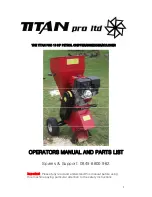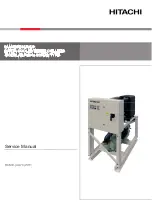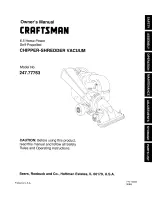
6
1 - INTRODUCTION
1.2 -
Equipment and components under
pressure
These products incorporate equipment or components under
pressure, manufactured by Carrier or other manufacturers. We
recommend that you consult your appropriate national trade
association or the owner of the equipment or components under
pressure (declaration, re-qualification, retesting, etc.). The
characteristics of this equipment/these components are given on
the nameplate or in the required documentation, supplied with the
products.
These units are intended to be stored and operated in an
environment where the ambient temperature must be not less
than the lowest allowable temperature indicated on the nameplate.
See chapter 9.2 “Pressure vessels”.
1.3 - Maintenance safety considerations
Carrier recommends the following drafting for a logbook (the table
below should not be considered as reference and does not involve
Carrier responsibility):
Intervention
Name of the
commissioning
engineer
Applicable
national
regulations
Verification
Organism
Date Nature
(1)
(1) Maintenance, repairs, regular verifications (EN 378), leakage, etc.
Engineers working on the electric or refrigeration components
must be authorized, trained and fully qualified to do so.
All refrigerant circuit repairs must be carried out by a trained
person, fully qualified to work on these units. He must have been
trained and be familiar with the equipment and the installation. All
welding operations must be carried out by qualified specialists.
Any manipulation (opening or closing) of a shut-off valve
must be carried out by a qualified and authorised engineer.
These procedures must be carried out with the unit shut-
down.
NOTE: The unit must never be left shut down with the liquid
line valve closed, as liquid refrigerant can be trapped between
this valve and the expansion device. (This valve is situated
on the liquid line before the filter drier box.)
Equip the engineers that work on the unit as follows:
Personal protection
equipment (PPE)
(1)
Operations
Handling
Maintenance,
service
Welding or
brazing
(2)
Protective gloves,
eye protection,
safety shoe,
protective clothing.
X
X
X
Ear protection.
X
X
Filtering respirator.
X
(1) We recommend to follow the instructions in EN 378-3.
(2) Performed in the presence of A1 refrigerant according to EN 378-1.
Never work on a unit that is still energized.
Never work on any of the electrical components, until the
general power supply to the unit has been cut using the
disconnect switch(es) in the control box(es).
If any maintenance operations are carried out on the unit,
lock the power supply circuit in the open position ahead of
the machine.
If the work is interrupted, always ensure that all circuits are
still deenergized before resuming the work.
ATTENTION: Even if the unit has been switched off, the power
circuit remains energized, unless the unit or circuit disconnect
switch is open. Refer to the wiring diagram for further details.
Attach appropriate safety labels.
Units with option 231 are equipped with capacitor batteries
with a discharge time of five (5) minutes after disconnecting
the power. After disconnecting the power to the control box,
wait five minutes before opening the control box. Before any
intervention, verify that there is no voltage present at any
accessible conducting parts of the power circuit.
Operating checks:
Important information regarding the refrigerant used:
•
This product contains fluorinated greenhouse gas
covered by the Kyoto protocol.
Refrigerant type: R-134a
Global Warming Potential (GWP): 1430
CAUTION:
1. Any intervention on the refrigerant circuit of this product
should be performed in accordance with the applicable
legislation. In the EU, the regulation is called F-Gas,
N°517/2014.
2. Ensure that the refrigerant is never released to the
atmosphere during installation, maintenance or equipment
disposal.
3. The deliberate gas release into the atmosphere is not
allowed.
4. If a refrigerant leak is detected, ensure that it is stopped
and repaired as quickly as possible.
5. Only a qualified and certified personnel can perform
installation operations, maintenance, refrigerant circuit
leak test as well as the equipment disposal and the
refrigerant recovering.
6. The gas recovery for recycling, regeneration or destruction
is at customer charge.
7. Periodic leak tests have to be carried out by the customer
or by third parties. The EU regulation set the periodicity
here after:
System WITHOUT
leakage detection
No Check 12 Months 6 Months
3 Months
System WITH leakage
detection
No Check 24 Months 12 Months 6 Months
Refrigerant charge/
circuit (CO
2
equivalent)
< 5 Tons
5 ≤
Charge
< 50 Tons
50 ≤
Charge
< 500 Tons
Charge
> 500 Tons
(1)
Refrigerant charge/ Circuit
(kg)
R134A
(GWP 1430)
Charge
< 3.5 kg
3.5 ≤
Charge
< 34.9 kg
34.9 ≤
Charge
< 349.7 kg
Charge
> 349.7 kg
R407C
(GWP 1774)
Charge
< 2.8 kg
2.8 ≤
Charge
< 28.2 kg
28.2 ≤
Charge
< 281.9 kg
Charge
> 281.9 kg
R410A
(GWP 2088)
Charge <
2.4 kg
2.4 ≤
Charge
< 23.9 kg
23.9 ≤
Charge
< 239.5 kg
Charge
> 239.5 kg
HFO’s: R1234ze
No requirement
(1) From 01/01/2017, units must be equipped with a leakage detection system.
8. A logbook must be established for equipments subject to
periodic leak tests. It should contain the quantity and the
type of fluid present within the installation (added and
recovered), the quantity of recycled fluid, regenerated or
destroyed, the date and output of the leak test, the
designation of the operator and its belonging company,
etc.
9. Contact your local dealer or installer if you have any
questions.
The information on operating inspections given in annex C
of standard EN 378 can be used if no similar criteria exist in
the national regulations.
While working in the fan area, especially when grilles or
casings are removed, disconnect the fan power supply to
prevent their automatic restart.
Содержание Aquaforce 30XAS Series
Страница 2: ...2...







































